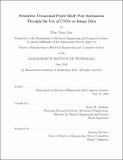Sensorless ultrasound probe 6DoF pose estimation through the use of CNNs on image data
Author(s)
Xue, Elise Yuan
DownloadFull printable version (4.571Mb)
Alternative title
Sensorless ultrasound probe six degree of freedom pose estimation through the use of CNNs on image data
Other Contributors
Massachusetts Institute of Technology. Department of Electrical Engineering and Computer Science.
Advisor
Brian W. Anthony.
Terms of use
Metadata
Show full item recordAbstract
Ultrasound probe pose estimation has many applications in medical practice and research. Currently, ultrasound probe pose estimation with respect to the human body requires the use of sensors attached to the ultrasound probe, and may get computationally costly. We explore the use of Convolutional Neural Networks (CNNs) to provide sensorless pose estimation. The Ultrasound CNN model proposed in this paper learns to regress the six degree of freedom (6-DoF) camera pose from a single ultrasound image in an end-to-end manner. Ultrasound images are easier to obtain than other forms of medical imaging, but suffer from poor quality, which will be a challenge for the Ultrasound CNN model. The most promising model from our experiments is a 23 layer deep CNN based off of GoogLeNet. In previous literature, CNNs have demonstrated that they can be used to solve complicated out of image plane regression problems. We show how the proposed method can regress the 6DoF pose within a certain degree of accuracy.
Description
Thesis: M. Eng., Massachusetts Institute of Technology, Department of Electrical Engineering and Computer Science, 2018. This electronic version was submitted by the student author. The certified thesis is available in the Institute Archives and Special Collections. Cataloged from student-submitted PDF version of thesis. Includes bibliographical references (pages 55-57).
Date issued
2018Department
Massachusetts Institute of Technology. Department of Electrical Engineering and Computer SciencePublisher
Massachusetts Institute of Technology
Keywords
Electrical Engineering and Computer Science.